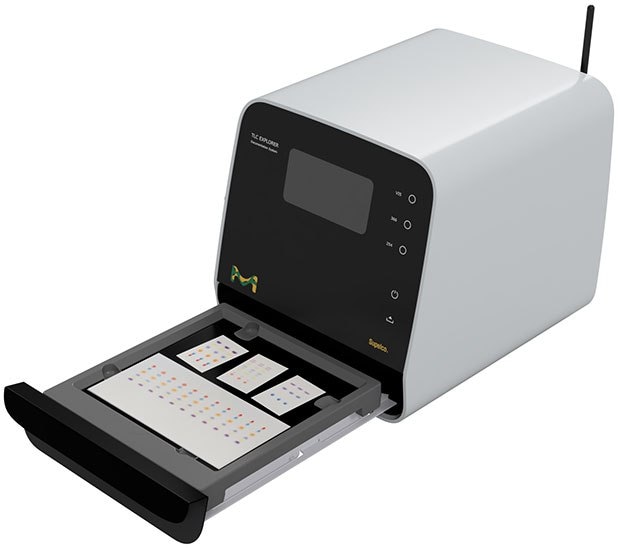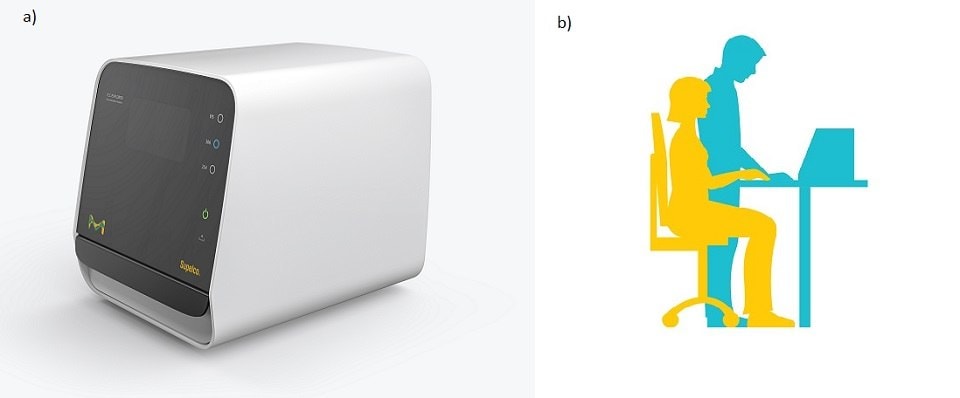Digitalize Your Analyses with the TLC Explorer
Digital TLC Analysis
Thin-layer chromatography (TLC) is a widely used analytical technique in chemistry, but traditional TLC plate analysis can be complex. The TLC Explorer provides a digitalized solution to enhance the efficiency and accuracy of quantitative analysis for more consistent and easily shareable data interpretation.
KEY FEATURES AND BENEFITS
Precise TLC Imaging: High-resolution digital imaging ensures detailed visualization of TLC, HPTLC, and PLC plates in less than 2 minutes, reducing subjectivity and inconsistent interpretations. Analyze single or multiplate plates at a time with automatic track recognition.
Reliable Quantitative Analysis: Converts spot intensity to numerical data via video densitometric measurement for easier TLC quantification. This makes it easier to measure concentration or compare results across experiments.
Streamlined Workflow Integration: Seamlessly connects to computers, tablets or smart phones for efficient data sharing and documentation.
User-friendly design for easy operation in typical laboratory settings:
- LED illumination of chromatogram via 3 light sources: white light, UV 366 nm and UV 254 nm, illuminate the plates from above in direct-light mode to enable easy identification of substances
- Easy plug-and-play setup with intuitive chromatography software
- Inspection window allows for quick visual check without the risk of UV exposure for enhanced safety
- Compact and portable for off-grid functionality
Related Resources
- Brochure: TLC Explorer Documentation System
Your Thin-Layer Chromatography (TLC) experience more convenient whether in analytical routine, method development, in-process control, or research.
- User Manual: TLC Explorer Documentation System
The TLC Explorer is designed to document and evaluate thin-layer chromatographic plates.
- Application Note: Reaction Monitoring of the Esterification Progress of Benzoic Acid using Thin-Layer Chromatography (TLC)
In this study, a qualitative reaction progress was analyzed.
- Application Note: Identification of Dexamethasone and its Derivatives by Thin-Layer Chromatography (TLC)
In this application note, we show different chromatography studies described in the European Pharmacopoeia (EP).
The glove-compatible touch sensors allow easy operation in typical laboratory settings. The plug-and-play experience eliminates the need for technical service support. To enhance its versatility, the instrument can function off the grid by utilizing a power bank (to be ordered separately), making it suitable for remote use.
The instrument includes a safety feature to protect against UV exposure during use. Plates (single or multiple) are securely placed on the Drawer Unit (Figure 1). The analysis only starts when the Drawer Unit is closed, ensuring no UV exposure. Additionally, the device uses more sustainable LED light sources instead of conventional lamps containing mercury.

Figure 1.Figure 1. TLC plates are positioned on a removable Baseplate (P1). The frame (P2) can be removed for easier handling. An alignment pin underneath the plate area (P3) helps the user to orient and align the Baseplate correctly on the Drawer (P4).
The digital documentation system provides flexibility and convenience throughout your entire TLC measurement process. You can easily connect to the system via WiFi or by scanning a QR code, making it operable on multiple devices (Figure 2).

Figure 2.Seamless operation of the TLC Explorer on a phone, laptop, and a tablet.
The intuitive software allows for TLC plate analysis without the need for time-consuming manual data processing and handling. It enables quick measurement of tracks in less than 2 minutes, with automated track recognition. Furthermore, the software facilitates simultaneous detection and measurement of multiple plates, covering an area of 20 x 20 cm (Figure 3).

Figure 3.Multiple TLC plates for analysis in the TLC Explorer.
The software can do an auto-image rotation in case the plate is improperly aligned prior to measurement in the device. Background noise reduction filters can be applied as needed. It also automatically pre-selects the starting line and solvent front, though manual addition and deletion of tracks, solvent, and starting line is also an option. Annotations, such as methodology details or naming conventions, can be easily added for further clarity. Moreover, the software facilitates both comparative and quantitative examinations of TLC and HPTLC plates.
The ergonomic design (Figure 6a), allows for quick examination of the plate through its inspection window (Figure 5). A shutter slider (Figure 4, F8) controls the opening to reduce disturbance from stray light entering the device while the user is looking through the inspection window. By pushing the shutter slider fully or only partially down, different parts of the baseplate can be seen.

Figure 4.TLC Explorer, Documentation system. F1: Power Button; F2, F3, F4: Illumination Buttons and Indicators for manual use; F5, F6: Drawer and “Drawer open” Indicator; F7, F8: Inspection Window and Shuttler Slider for visual plate analysis.

Figure 5.Open inspection window for safe visual check. Image shows an illuminated plate under UV 254 nm excitation.
The device has three types of excitation sources that can be easily switched on by a light tap on the touch sensitive buttons indicating the wavelengths (Figure 4, F2 – 4). However, only one of these light sources can be active at a time.

Figure 6.The front of the device has an angle of 12° (a) allowing a more ergonomic operation while sitting (b) and standing.
To continue reading please sign in or create an account.
Don't Have An Account?